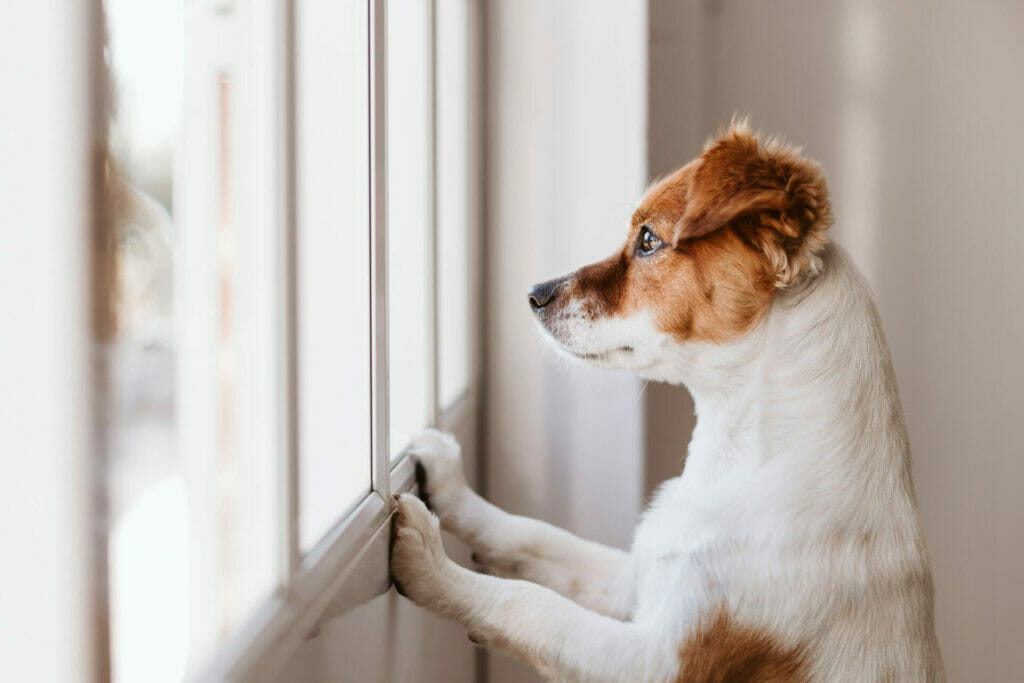How long can you leave your dog? It’s a question that comes up often for dog owners. The answer differs based on a number of factors. Consider your dog’s age, temperament, energy level, and lifestyle.
How long can a dog stay alone?
All dogs should be comfortable spending time at home alone. This basic training skill helps prevent separation anxiety. But how long can dogs be left alone? At maximum, a healthy adult dog can be left home alone for six to eight hours without a bathroom break or enrichment time. However, less is best when it comes to regular time spent at home alone. Dogs thrive on spending time with their people. as social creatures.
How long can a puppy or senior dog stay alone?
Puppies have smaller bladders and need to potty more frequently. Puppies are not physically or emotionally capable of being left home alone for as long as mature dogs. The general rule about puppies is one hour for every month of life. This means that a three-month-old puppy can be left alone for three hours maximum. On the other hand, as dogs get older, it’s harder for them to spend extended periods of time on their own. Senior dogs, like puppies, need more frequent trips out to the potty. Senior dogs also are sensitive to alone time.
Location matters
Location influences how long a dog can be left alone. Crate training makes potty training easier and teaches your dog basic manners. However, dogs confined to a crate should be left for the least amount of time possible, and never for an entire six-to-eight-hour day. Even dogs who like their crate shouldn’t be crated for long periods of time. Crates don’t give dogs enough space to play, walk around, or move to different positions. So if you know that your dog needs to be left for an entire workday or prolonged period, keep them in a dog-proof an area.
Mental enrichment
When leaving your dog home alone, make sure they have access to enrichment activities. Giving your dog access to dog-safe chews, toys, and enrichment puzzles keeps your dog engaged while you are away. Kongs and other hollow hard rubber toys can be filled with (dog-safe) peanut butter, UnKibble, and other dog treats to keep your dog occupied while you’re away. This helps keep your dog entertained and can even prevent destructive or disruptive activities. (Think barking, chewing furniture and other objects, or digging at floors).
Maximize time together
It’s also important to maximize the time you do have with your dog. Take advantage of the opportunities you and your dog have when you’re together. If you know you’ll need to leave your dog home alone for most of the day, get up early to get some playtime in. Also try a long walk and work on training games. The key is ensuring your dog has physical and mental enrichment before you leave. It’s also an opportunity for bonding time and helps your dog cope with longer periods of time away from you.
Get support
Seeking support, especially if it limits your dog’s prolonged periods home alone. When you leave your dog home alone consider getting help from a friend, family member, or a professional dog walker. This gives your dog a chance to potty and play. In turn, this decreases the likelihood of your dog’s distress.

If your dog struggles with alone time, it’s best to consult a dog trainer specializing in separation anxiety right away. Make sure that your dog trainer utilizes positive reinforcement training approaches. Alternatively seek help from a veternarian. Vets can help your dog learn to self-soothe while being home alone.
All dogs should spend some time home alone, but it’s important to be thoughtful and considerate. Leave your dog alone for a reasonable amount of time given their needs. For adult dogs, six to eight hours is the absolute maximum amount of time that dogs are left on their own. For puppies and senior dogs, consider leaving them for even shorter periods of time.




















